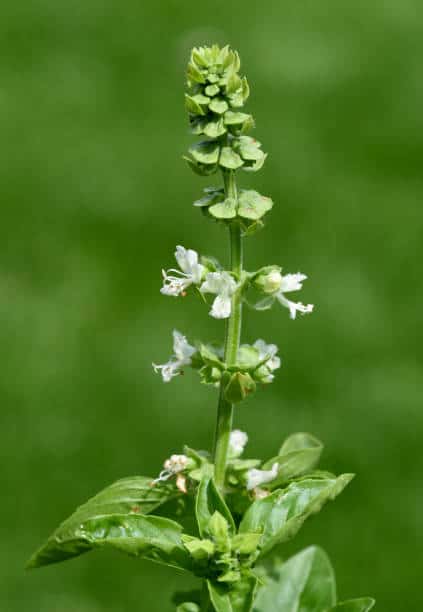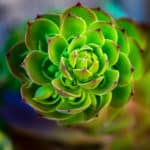What It Means If Your Basil Plant Has Flowers:
Basil Flower is an annual. It means it will die after a season and must be replaced. The plant should not survive the winter if leaves are flowering.
Basil is a very hardy plant and can withstand harsh weather conditions provided the soil is well-drained. It can be grown indoors or out but it will do best if kept in bright sunlight all day long.
Guiding light for 12 hours a day should be fine.
Why Basil displays flowers?

Basil is an annual, edible herb producing flowers when isn’t regularly pruned. If basil is left to grow the basil will also produce white flower purple flowers (depending on the variety) and look pretty.
The basil flowers then direct the basil’s total energies to produce the seeds that can be retrieved and then sow next year.
Different basil varieties can be cross-pollinated so the seed is not necessarily the same variety of basil as the ones being grown.
When gardening for cooking use it is good to prune basil before it forms flower which will stimulate more production of aromatic leaves.
What to Do with a Flowering Basil Plant:
The flowering period of basil is quite short. Once the flowers have produced seeds you will need to tear out the main stem and most likely the leaves too as they will be wilted.
Basil can be used fresh or dried. It is good to harvest often while in flower so that it does not pass its prime quality for cooking.
If the leaves have been flattened out by the rain or wilted from lack of sunlight you can still harvest them for cooking.
Basil that has gone to flower is probably better used as compost than in food so avoid using it in dishes after flowering occurs and instead look to enjoy its flowers and seeds as a beautiful addition.
Is basil safe to eat after flowering?
It’s an edible ‘herbal’ and the leaves are safe in your garden after they’re fully formed. The taste of the leaves is milder in taste or bitter than the typical sweet aroma of the young leaves.
What to Do with Basil Flowers:
The flowers of basil are edible as well. As many types of basil produce a small flower it means that the aromatic leaves and flowers can be eaten at the same time.
The flowers are safe to eat and do not have a strong flavor. It’s best to harvest the flowers after they’ve produced seeds as it will stimulate more leaves for you to enjoy.
Basil leaves are safe to consume if they’re growing in well-drained soil. The stems can be tough but the leaves and flowers add subtle flavor with their light aroma.
Determine If Your Basil is Flowering:

If you want to know what your basil plant is doing, it’s best to pay attention to its growth cycle as different plants bloom at different times of the year sacrificing productivity for beautification.
The small white or purple flower of basil indicates that there will not be any production of new leaves during this time until seeds have been produced which will then force the basil plant into rest mode where it regains its energy before returning back into full productivity.
What Happens if Basil Flowers:

If your basil plant is flowering chances are good that you need more sunlight so ensure you’re growing it outside during daylight hours on a regular basis rather than indoors in order for it to make healthy leaves that can be used in recipes
In fact, many varieties of basil mean that you will get several crops each growing season. To enjoy your plant to its fullest harvest often and keep an eye on harvests for your garden as soon as it flowers.
A properly pruned basil can yield tasty leaves during summer if properly watered and trimmed. Keep in your mind that the tender basil vines decompose before frost thus ensuring you can use all leaves before they die in Winter. If your basil has wilted read my article about what happens to the wilted basil plants.
Brew Basil Tea:
To get the most out of the basil flowers, you can use them to brew your own tea. You will need a clean jar or a pot with some holes on top. You will also need steeped black tea and 4-5 fresh flowers from your basil plant (basil varieties that produce blue flowers are not recommended for this practice).
Place the flowers into your pot or jar and cover them with steeped black tea. Then, just let it sit, in a dark and cool place for 4-5 days before drinking. You can add some honey to sweeten if you prefer!
Basil Ice Cubes:
If you’re looking for an easy way to enjoy the flavor of basil in a beverage, you can infuse it into ice cubes. Simply fill an ice cube tray with water and place one or two fresh basil leaves on top of each stack. Cover the tray with plastic wrap and freeze until solid (about 4 hours).
Basil Plants as Pots:
If your Basil plants are flowering and have lots of seeds you can place them in a small pot to let them grow. You will need to water the flower regularly and ensure that they won’t wilt.
This is a perfect way to try out growing basil indoors during winter months, for those who want to keep up with fresh basil all year round!
Harvesting basil flowers
A wide variety of experienced growers find that letting basil flowers bloom won’t change the plant’s culinary properties suddenly but all as a matter of course. Leaf slits will grow at a similar rate as earlier.
The trick is not to leave too many flowering petals on the plant. Lucky for most tastes it’s the time when flower flowers become tender and delicious. So it’s possible to sneeze the entire flowering branch away without degrading them or even the whole flower itself from its stem.
After all the blooms are over the plant will move to newly growing leaves and become bushy.
How do I stop basil from flowering?
It is relatively easy to prune basil and no machine is required as you simply pinch and trim and prepare for cooking. During summer it is a good practice to prune your basil once every couple of weeks to prevent it from becoming leggy and exhibiting bloom spots.
Once you start pruning your basil regularly, it won’t take long for you to get the hang of it.
The main reason why some people don’t cut their basil enough is that they worry they will reduce yield and plant appearance. But in fact, if not pruned, the plants will become spindly as there’s nothing left green to feed on. Eventually, all the leaves will be dead and old and little leaf area will be available for photosynthesis, which leads to a decrease in production.
Opinions vary on how much is too much when it comes to cutting back or pinching back certain plants! Some gardeners think that more is better while others believe just a bit goes a long way.
This is where having lots of different varieties of plants comes in handy because you can experiment and decide for yourself the best way to treat each plant, depending on your objectives.
For example, say one variety performs poorly when pinched back but another thrives. Or, a certain variety won’t flower as readily if it’s pinched back while others don’t seem to mind.
You will also find that pruning rules change slightly every season or with new growth so stay tuned for more tips! After all this effort I hope you enjoy fresh basil in all its glory throughout the summer months. The possibilities are endless when it comes to growing basil!
Let us know how you’ve used yours thus far in the comments below and don’t be shy to share some of your favorite recipes and tips!
If flower growth is occurring just to trim a pair of scissors which redirects energy within plants producing leaves.
In the morning you can prune basil as this is the best time for getting essential oils.











